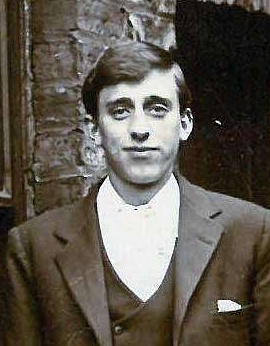
Alfred Myers came from a large family in East Cleveland and before the war worked with two of his brothers in the ironstone mines. A member of the Independent Labour Party and a devout Wesleyan Methodist, he played a key role in his local community. He was a tenor in the Wesleyan Carlin How choir, a Sunday school superintendent and trustee of the local church.
Myer’s service record survives and records the process of his arrest and sentencing in cold, hard terms. One month after his posting he was arrested and court-martialled. Initially he was sentenced to death but this was commuted to 10 years imprisonment.
At his hearing for exemption from compulsory military service, Myers asserted his belief in an international brotherhood of man, and stated that he ‘could not conscientiously kill, nor assist in killing’. But like so many others he was only granted exemption from combatant service and was sent to the Non-Combatant Corps at Richmond Castle.
In the cells at Richmond, Myers’s tenor voice was put to good use. With two other conscientious objectors, Brocklesby and Gaudie, he sang the hymn ‘Nearer My God to Thee’ in three-part harmony. Myers’s performance wasn’t as perfect as the other prisoners hoped, however – they had to bang on the cell floor to keep him in time.
Following his ordeal with the rest of the Richmond Sixteen in France, Myers was sent first to Dyce Camp, near Aberdeen, and then Maidstone prison. Others of the Richmond Sixteen were also there, and Myers worked alongside Brocklesby in the laundry.
On his release, the effects of imprisonment were evident. Brocklesby described in his memoirs how on their journey home ‘poor old Alfred … was suffering from an emotional or nervous reaction and felt unable to go further alone’.
Explore more memories from the ribbon
-
2nd Lieutenant Thomas Charles Goode M.B.E.
Researched by John Mills. Born 27th of January 1880 Thomas was the son of Sergeant Valentine Goode also of the Yorkshire Regiment and his mother was called Helen. He was part of a large family; he had five brothers and two sisters. He enlisted in Richmond on the 27th of August 1897. Being a first rate rifle shot he devoted himself to musketry and became an instructor. He served throughout the whole of the Boer War with the 1st Battalion. He was awarded the Queen’s medal with 6 clasps and the King’s with 2. In 1905 he married Mary Agnes Grace Dobinson. In 1914 he was with the 1st Battalion in India, his campaign medals indicate he was in France some time after 1915. He became a 2nd lieutenant in the Somerset Light Infantry (Prince Albert’s). He survived the war and retired with the rank of Captain on the 8th of June 1920. He was awarded the M.B.E. on the 3rd of June 1919 for his services in connection with the war in India. He must have returned to the army to serve in World War 2 because he has campaign medals (World War 2 service medal and war medal). Perhaps this might have been in some form of instructor role.
-
2nd Lt J S Purvis
Canon John Purvis OBE (1890-1968) Canon John Purvis was an extremely talented artist and photographer. He is best remembered however for his historical and literary achievements. His translation of the original York Mystery Plays into modern English were central to their revival during the Festival of Britain in 1951. This work, along with his initiation of the Borthwick Institute for Archives in York, lead to his OBE in 1958. Purvis was born in Bridlington 1890. After studying at Cambridge University he worked at Cranleigh School as a history teacher, a role to which he would return after the First World War. He enlisted with the Yorkshire Regiment, serving with the 5th Battalion from early 1916. Purvis was wounded during the Battle of the Somme on the first occasion he went ‘over the top’. On that day, 15th September 1916, he had recorded history’s first tank attack in pen and ink in the early light of dawn. Two well known war poems, ‘High Wood’ and ‘Chance Memory’, originally published under the pseudonym Philip Johns(t)one are now known to have been written by Purvis.
-
Fred Sheilds
Fred was the youngest son of Joseph Shields, a Castle Bolton plumber and tinsmith. He was born around 1897. The 1911 census shows the family as having 3 children, Alice, 28, Joseph, 26, and Fred, 14, with his wife Elizabeth. They lived in a section of Bolton Castle, acting as caretakers, with Elizabeth providing refreshments for visitors. They also had a tinsmith’s shop in a building across from the castle making kettles and pans etc. which today is a storeroom. Fred enlisted at Northallerton on the 7th December 1915 and joined the 8th Battalion Yorkshire Regiment. Early in July 1917 Fred arrived with a detachment of men at Steenvoorde in northern France adjacent the Belgium border in the area west of Ypres. It was during the 3rd Battle of Ypres, better known as Passchendaele, that Private Fred Kilding Shields was killed. A shell burst in the trench where Fred and 3 others died, He was just 21 years old. Fred is buried at Tyne Cot Cemetery.
